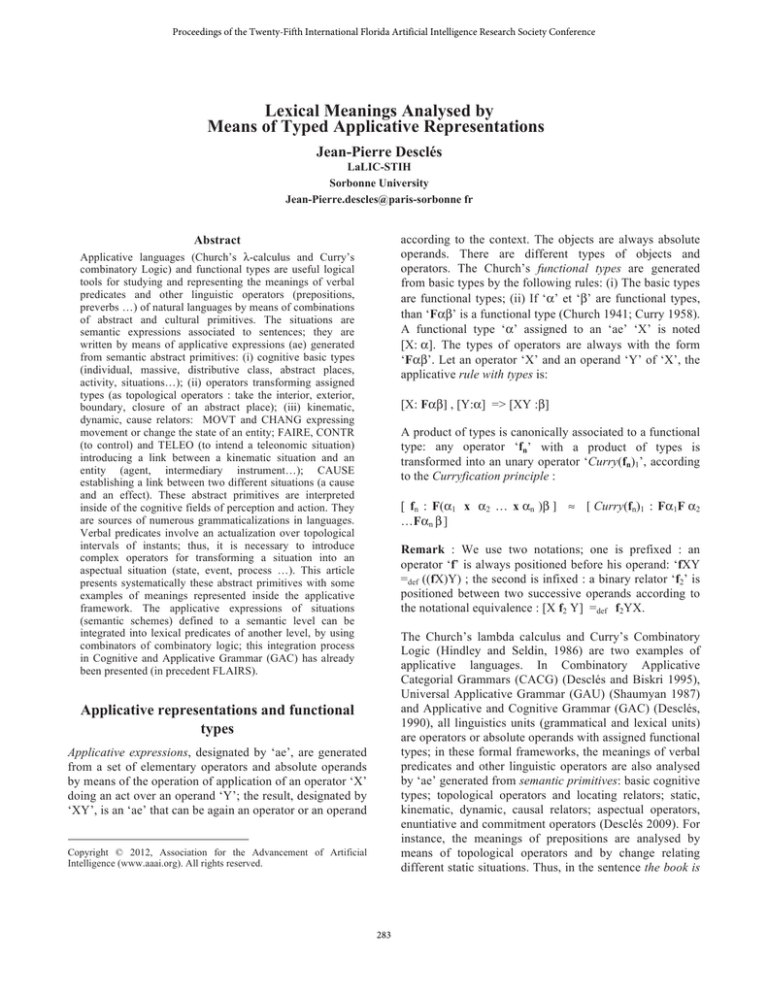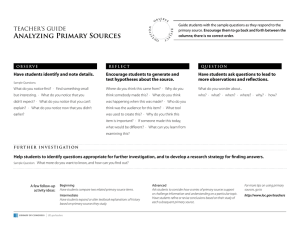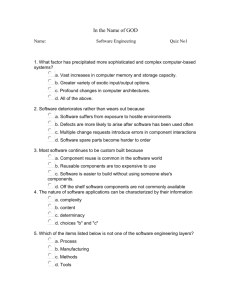
Proceedings of the Twenty-Fifth International Florida Artificial Intelligence Research Society Conference
Lexical Meanings Analysed by
Means of Typed Applicative Representations
Jean-Pierre Desclés
LaLIC-STIH
Sorbonne University
Jean-Pierre.descles@paris-sorbonne fr
according to the context. The objects are always absolute
operands. There are different types of objects and
operators. The Church’s functional types are generated
from basic types by the following rules: (i) The basic types
are functional types; (ii) If ‘α’ et ‘β’ are functional types,
than ‘Fαβ’ is a functional type (Church 1941; Curry 1958).
A functional type ‘α’ assigned to an ‘ae’ ‘X’ is noted
[X: α]. The types of operators are always with the form
‘Fαβ’. Let an operator ‘X’ and an operand ‘Y’ of ‘X’, the
applicative rule with types is:
Abstract
Applicative languages (Church’s λ-calculus and Curry’s
combinatory Logic) and functional types are useful logical
tools for studying and representing the meanings of verbal
predicates and other linguistic operators (prepositions,
preverbs …) of natural languages by means of combinations
of abstract and cultural primitives. The situations are
semantic expressions associated to sentences; they are
written by means of applicative expressions (ae) generated
from semantic abstract primitives: (i) cognitive basic types
(individual, massive, distributive class, abstract places,
activity, situations…); (ii) operators transforming assigned
types (as topological operators : take the interior, exterior,
boundary, closure of an abstract place); (iii) kinematic,
dynamic, cause relators: MOVT and CHANG expressing
movement or change the state of an entity; FAIRE, CONTR
(to control) and TELEO (to intend a teleonomic situation)
introducing a link between a kinematic situation and an
entity (agent, intermediary instrument…); CAUSE
establishing a link between two different situations (a cause
and an effect). These abstract primitives are interpreted
inside of the cognitive fields of perception and action. They
are sources of numerous grammaticalizations in languages.
Verbal predicates involve an actualization over topological
intervals of instants; thus, it is necessary to introduce
complex operators for transforming a situation into an
aspectual situation (state, event, process …). This article
presents systematically these abstract primitives with some
examples of meanings represented inside the applicative
framework. The applicative expressions of situations
(semantic schemes) defined to a semantic level can be
integrated into lexical predicates of another level, by using
combinators of combinatory logic; this integration process
in Cognitive and Applicative Grammar (GAC) has already
been presented (in precedent FLAIRS).
[X: Fαβ] , [Y:α] => [XY :β]
A product of types is canonically associated to a functional
type: any operator ‘fn’ with a product of types is
transformed into an unary operator ‘Curry(fn)1’, according
to the Curryfication principle :
[ fn : F(α1 x α2 … x αn )β ] ≈ [ Curry(fn)1 : Fα1F α2
…Fαn β ]
Remark : We use two notations; one is prefixed : an
operator ‘f’ is always positioned before his operand: ‘fXY
=def ((fX)Y) ; the second is infixed : a binary relator ‘f2’ is
positioned between two successive operands according to
the notational equivalence : [X f2 Y] =def f2YX.
The Church’s lambda calculus and Curry’s Combinatory
Logic (Hindley and Seldin, 1986) are two examples of
applicative languages. In Combinatory Applicative
Categorial Grammars (CACG) (Desclés and Biskri 1995),
Universal Applicative Grammar (GAU) (Shaumyan 1987)
and Applicative and Cognitive Grammar (GAC) (Desclés,
1990), all linguistics units (grammatical and lexical units)
are operators or absolute operands with assigned functional
types; in these formal frameworks, the meanings of verbal
predicates and other linguistic operators are also analysed
by ‘ae’ generated from semantic primitives: basic cognitive
types; topological operators and locating relators; static,
kinematic, dynamic, causal relators; aspectual operators,
enuntiative and commitment operators (Desclés 2009). For
instance, the meanings of prepositions are analysed by
means of topological operators and by change relating
different static situations. Thus, in the sentence the book is
Applicative representations and functional
types
Applicative expressions, designated by ‘ae’, are generated
from a set of elementary operators and absolute operands
by means of the operation of application of an operator ‘X’
doing an act over an operand ‘Y’; the result, designated by
‘XY’, is an ‘ae’ that can be again an operator or an operand
Copyright © 2012, Association for the Advancement of Artificial
Intelligence (www.aaai.org). All rights reserved.
283
on the table, the preposition on express an upper side of the
place “the table”. The verbal meanings are analysed by
means of different and successive situations located in a
temporal framework reference and represented by semantic
and cognitive schemes (SSC); the components of these
SSC are ‘ae’ with assigned functional cognitive types
(Abraham 1995; Abraham and Desclés 1992; Djioua
2000). The “combinators” (abstract operators for
combining and transforming operators) of Combinatory
Logic (Curry 1958) are useful tools to explain on one side,
in a top down approach (or in a synthetic integrative way),
how a scheme - an applicative representation of a verbal
meaning - can be integrated into a predicate frame with an
appropriate number of terms functioning as operands and,
in other side, in a bottom up approach (or an analytic way),
how a lexical predicate can be semantically decomposed
and represented by an applicative scheme (Desclés 1990,
2004, 2010). In this presentation, in first, we list basic
cognitive primitives types, associated to different kinds of
objects and secondly, we precise systematically different
primitive semantic operators and relators used by building
static and evolutive (kinematic and dynamic) schemes. The
basic types, operators and relators can be closely linked to
a cognitive perception of environment and to actions onto
this environment. Thus, this model belongs to the field of
cognitive representations (Langacker 1987, 1991; Cruse
1986; Desclés 1990, 1995; Lüdi and al. 1995; Croft and
Cruse 2004; Pottier 2000) where the categories of natural
languages interact with the categorizations organized by
perception and action abilities of humans, with a more or
less important intention.
- Sitstatic-space : type of static situations in the space
- Sitevol : type of evolutive situations with two subtypes :
Sitkinem : type of cinematic situations and Sitdynam : type of
dynamic situations
- Sitcaus : type of causal situations
The meanings of lexical predicates are represented by
situations viewed as applicative expressions that are
compositions of the above abstract semantic primitives
with some other cultural primitives deeply related to social
experiences and technology. For instance, to-be-alive is
related to the human experience, it is considered as a
cultural primitive. A situation is an ‘ae’ representing a fact
(actual or imaginary), that is a denotation associated to a
propositional expression. There is a deep relation between
the type ‘Sit’ of situations and the type ‘H’ of true values;
indeed, a situation must be actualized onto a temporal
domain (or spatio-temporal) and this actualisation entails
an evaluation by true values, hence : [situation : Sit] if and
only if [actualization (situation) : H ]
Remarks : 1°) The type of a relation between n entities is:
‘Fα1F α2 …FαnH’. A binary relator ‘f2’, used for
expressing a situation with two operands, builds up, by the
same way, an expression with the type H, hence the
equivalence:
[U:α], [V:β], [f2: FαFβSit] <=> [U:α], [V:β],[f2: FαFβH]
2°) The type ‘FJH’ is the type of a property (or a concept
applied to individuals with type J); it is a subtype of the
type D of distributive classes.
Basic cognitive types
Operators for changing basic types
Different operators transform the cognitive types assigned
of a given entity. Let us take examples:
We consider different cognitive types of absolute operands
(“objects”):
- The operator Loc transforms the type J of an individual
object A into the type L : Loc(A) is now viewed as a place:
[Loc : FJL], [A : J] => [Loc(A) : L];
- J : type of individual (and enumerable) objects as: John,
this car, a table, an human
- M : type of massive (and no enumerable) objects as:
butter, water,
- I : type of content of information as: (read in) the
newspaper
- L : type of abstract places with subtypes : LS : spatial
place as: in this street / on the table; LT : temporal place
as an interval of successive instants: (in) afternoon, (in)
this year; LA : activity: (in) love, (in) working
- D : type of distributive classes as: the humans (a class of
humans), the cars (a class of cars)
- K :type of collective class as: the army, an administration
- H : type of propositional expressions with two possible
values: true and false
- T : type of intervals of instants
- Sit : type of situations with subtypes of situations :
- Sitstatic : type of static situations
- Topological operators act upon a place Loc(A) to define a
part of this place:
[A : J], [Loc : FJL], [Top : FLL] => Top(Loc(A)) : L];
- The operator Ind transforms an entity (with any type α)
into an entity with the type ‘J’ of individual objects:
[Ind : FαJ], [A: α] => [Ind(A) : J].
Let us give some examples:
- [Loc: FJL] , [an house : J] => [Loc(an house) : L]
To sell two houses / to be in an house;
- [a-part-of : FMJ], [butter : M] => [a part of butter : J ];
- [one book : J ] => [ Top (Loc(one book)) : L ]
one book / on a book.
284
membership (∈) of an individual entity to a class;
mereonomic ingredience (ε) between a part and a whole;
inclusion (⊂) between classes; relators of locating (islocated) relative to an abstract place, for instance
topological places; relator (has-access-to) meaning that
somebody may access to an object, a place, an activity…:
Topological operators defined on abstract places
There are topological operators acting onto places with the
type ‘L’: “to take the interior of” (Int), “to take the closure
of” (Clos), “to take the exterior of” (Ext), and “to take the
boundary (a frontier) of” (Fro) ; for instance:
- in a house → Int(Loc(house))
- at the house → Clos(Loc(house))
- out of a house → Ext(Loc(house))
- on the boundary of the river → Fro(Loc(the-river))
[ = FJFJH ] :
[Socrates = the master of Plato]
[ε : FMFMH] : [butter ε butter] ; [water ε a river]
[∈ : FJFDH] : [ Socrates ∈ {x; is-a-philosopher (x)} ]
[⊂ : FDFDH] : [{x; is-a-man(x)} ⊂ {x; is-an-animal
(x)}]
[is-located : FJFLH] : [John is-located (Int(Loc(Florida))) ]
[has-access-to: FJFJH] : [John has-access-to books ]
Let us take a global space Loc(U), defined as a set of
possible positions taken by an object in this space; Loc(X)
is a part of the global place Loc(U). The two topological
operators ‘Int’ and ‘Clos’ define a Kuratowski’s algebra
(Kelley 1961 : 43; 56-57) on places with the following
properties:
Static situations expressing different spatial positions of an
object (the ball) relative to a place (the swimming pool) are
for instance:
Int(Loc(X)) = Loc(X)
Int(Loc(X)) ⊆ Loc(X)
Int(Loc(X1) ∩ Loc(X2)) = Int(Loc(X1)) ∩ Int(Loc(X2)
Int(Int(Loc(X)) = Int(Loc(X))
Clos(Loc(∅)) = Loc(∅) = ∅
Clos(Loc(X)) ⊇ Loc(X)
Clos(Clos(Loc(X)) = Clos(Loc(X))
- [(the-ball) is-located (Int(Loc(the- swimming pool))) ]
- [(the-ball) is-located (Ext(Loc(the- swimming pool)))]
- [(the-ball) is-located (Fro(Loc(the-swimming pool))) ]
Evolutive (kinematic and dynamic) operators
A kinematic situation express a transformation (a
movement or a change) from one static situation SIT1
oriented towards a terminal situation (or to a situation in
progress) SIT2. ‘MOVT’ and ‘CHANG’ are two kinematic
relators with functional types:
We derive other topological operators from these two basic
operators ant the complementary operator with specific
properties:
Ext(Loc(X)) =def Loc(U) − Clos(Loc(X))
Fro(Loc(X)) =def Clos(Loc(X)) − Int(Loc(X))
Fro(Loc(X)) =def Clos(Loc(X)) ∩ Clos(Ext(Loc(X))
Int(Loc(X) is the biggest open place contained in Loc(X)
Clos(Loc(X)) is the most small place containing Loc(X)
MOUVT : F Sitstatic-space F Sitstatic-space Sitkinem
CHANG : Fsitstatic F Sitstatic Sitkinem
The relator MOUVT is restricted to movements in space;
the relator CHANG is used for changing or transforming
the properties affecting an object. In a spatial movement, a
new situation SIT2 is built from a given SIT1 by the
operator MOVT° (with the type Fsitstatic sitstatic ) and the
kinematic situation (viewed as a binary relation):
The different topological places of a global place Loc(U)
are organized in a network with inclusions between places,
overlapping, connection by boundaries... (Egenhofer and
Herring 1990; Casati and Varzi 1999; Pustejovsky 2009). These
topological operations are used for representing the
meanings of prepositions (Desclés and Guentchéva 2010).
[ SIT2 = MOVT° (SIT1) ]
[ Sitkinem = MOVT (SIT1) (SIT2) ]
Static Archi-relator (rep) for locating
Locating archir-relator ‘rep’, introduced in linguistics by
A. Culioli (1968, 1999) and formalised by (Desclés and
Froidevaux, 1982; Desclés 1990) generates abstract
schemes of locating ‘rep VU’ (or, with a prefixed notation:
[U rep V]) between a located entity ‘U’ and a locating
entity ‘V’:
The change of properties of an entity generates a similar
unary operator CHANG° and binary relation.
Remark : We designate by ‘SIT [x,y,..]’ a situation where
‘x’, ‘y’, … are involved as being parameters. For instance,
the meaning of the lexical verb to enter in the sentence The
ball enters the room, is represented by the following
kinamatic scheme (a movement from the outside of into
inside of a same place):
[U : α], [V: β], [rep: FαFβ H] => [rep VU : H]
Several semantic values are specifications of this general
archir-relator ‘rep’ : identification (=) between entities;
MOVT (SIT1 [x, y]) (SIT2 [x, y])
285
whith : SIT1 [x, y] =def is-located (Ext(Loc(y))) x
SIT2 [x, y] =def is-located (Int(Loc(y))) x
[ x := the-ball] ; [y := the-room]
The lexical verb to enter in the sentence John enters his
car in the garage is now represented by the dynamic
scheme (with a control onto the movement):
A dynamic situation express that an entity (often an
individual entity) produces a kinematic situation by
controlling or not this production. The primitives FAIRE,
CONTR and TELEO are dynamic relators. FAIRE builds a
relation between the entity producing and a produced
cinematic transformation. CONTR (to control) express that
an agent has a control over a kinematic situation (or a
dynamic situation), that is this agent has the ability to start
and also to stop a movement or a change expressed by a
kinematic or a dynamic situation. An agent can control a
transformation (a movement or a change) by an
intermediary (for instance, an instrument) that produces
effectively this transformation. TELEO holds between an
agent (an entity having the ability to start and to stop a
cinematic or dynamic situation) and an intended situation.
The primitive CAUSE establish a relation between two
situations where the first is the cause (an event or a class of
events), of the second (the effect, result, side effect …).
The types of these dynamic relators are:
CONTR (MOUVT (SIT1stat [x,y]) (SIT2stat [x,y]) u
with :
The meaning of to involve in the sentence Being a soldier
involves getting killed is represented by a causal scheme:
CAUSE (SIT1stat [x]) (SIT2 cinem [x])
with:
SIT1stat [x]) =def being-a-soldier (x)
SIT1kinem [x]) =def getting (to-be killed (x))(x)
[ x = anybody ]
Aspectual operators : EVEN
PROC J
F,
STATE
O,
A situation is expressed by an ‘ae’; it represents a fact
(actual or imaginary), it is a denotation associated to a
proposition. Since each verb contains an underlying
temporal dimension, it is necessary to introduce aspectual
operators for giving this dimension. Each aspectual
operator transforms into an aspectualised situation a
proposition - a predicative relation or a “lexis”, designated
by ‘Λ’, in the sense of Culioli (1999), -; this aspectualised
situation is actualised over a topological interval of instants
(with open or closed bounds). The aspectual scheme
associated to this operator ASPI is given by:
- FAIRE : FJ F Sitkinem Sitdynam
- CONTR : FJ F Sitevol Sitdynam
- TELEO : F J F Sit H
- CAUSE : F Sit Sit
We can express different dynamical semantico-cognitive
schemes (SSC); for instance:
- FAIRE (CHANG (SIT1stat [y] )( SIT2stat [y])) x
- CONTR (CHANG (SIT1stat [x])( SIT2stat [x])) x
- CONTR (FAIRE (CHANG (SIT1stat [x,y])( SIT2stat [x,y])) v) x
- [ (CONTR (FAIRE (CHANG (SIT1stat [x,y])( SIT2stat [x,y]))v)x)
& (TELEO (SIT2stat [x,y]) x) ]
- CAUSE (SIT1 [x,y]) (SIT2 [u,v])
[Λ: H ] , [ ASPI : F Sit FT Sit ] [ I : T] =>
[ ASPI (Λ) : Sit ] & [ASPI(Λ) : H]
The expression ‘ASPI(Λ)’ is an aspectualised situation; it
express that the predicative relation ‘Λ’ is viewed as a state
or an event or a process actualised over a topological
interval ‘I’ (where ‘T’ is the type of intervals of instants)
and it is true at different instants of this interval ‘I’
according to the choice of aspect (Desclés 1989; Desclés
and Ro 2011).
An state is actualised as a static situation actualised over
an open interval O : ‘Λ’ is true at any instant of O; for each
open interval O’ included into O, ‘Λ’ is also true.
An event is actualised as an evolutive situation : ‘Λ’ has
been actualised on the close interval F; it is true at the
closed bound at right of F; for any closed interval F’
included in F, ‘Λ’ is in general no true.
A process is an actualisation of an evolutive situation such
that it is actualized over an interval J with a closed bound
at left and an open bound at right ; it is true at any instant
of the interval J but it is not true at the right open bound of
These schemes are useful to explain the grammatical roles
(“agent”, “patient”, “instrument”, “experiencer” “location”,
…) by means of abstracts relations defined inside a SSC.
For instance, a middle scheme indicates that an agent
controls his action affecting himself; a semantic transitive
scheme indicates that an agent controls a change affecting
a patient and not directly the patient. Let us give examples
of SSC. The meaning of the lexical verb to enter in the
sentence John enters the room is represented by the
dynamic scheme (without a control onto the movement):
CONTR (MOUVT (SIT1stat [u,y]) (SIT2stat [u,y])
with :
SIT1stat [x,y] =def is-located (Ext(Loc(y)))
SIT2stat [u,y] =def is-located (Int(Loc(y))) x
[ u := John]; [y := the-garage] ; [ x := his-car]
SIT1stat [u,y] =def is-located (Ext(Loc(y))) u
SIT2stat [u,y] =def is-located (Int(Loc(y))) u
[ u := John]; [y := the-room]
286
boundary δ(F) at right of F is identical with the open
boundary γ(O3) at left of O3 (Desclés 2005; Desclés and Ro
2011).
J, because the process is not complete. If an interval J’,
with an open bound at right, is such that the closed bounds
at left of J’ and J are the same, then ‘Λ’ is also true for any
instant of J’. In a complete process, the right bound of the
interval J became closed, then the complete process
generates an event.
An event is an aspectual specification of a situation
expressed by a predicative relation; it does not admit a
subclassification
into “Processes”, “States”
and
“Transitions” as Pustejovsky (1995: 68, 246) assumes (see
also Pustejovsky and al., 200); for us, event is not a generic
notion but a transition between two states and it can be
generated from a complete process.
Analysis of the meaning of to give
A lot of linguistic publications in Cognitive Semantics (for
instance, R. Langacker 1987, 1991; Pottier 2000) present
an analysis of the meaning of the lexical predicate to give,
by using the primitive of “possession”. We replace this
primitive by the more abstract and general primitive hasaccess-to to take in account different uses of this lexical
predicate. Indeed, when somebody gives his arm or gives
information, he does not lose his arm or the exchanged
information. The more general representation of to give in
John gave information to his friend is:
Analysis of the meaning of to kill
It is known that the meaning of to kill has been analysed by
McCawley (1993) (from the deep predicates CAUSE,
BECOME, TO BE ALIVE and the negation NEG (Dowty,
1979; Cann, 1993). By a different way in using other
primitives and an applicative language, we analyse the
meaning of the tensed verb killed in the sentence John
killed a deer from the following scheme:
EVENTF (CONTR (CHANG (SIT1stat [x,y,z])(SIT2stat [x,y,z]) x ))
with :
EVENTF (CONTR (CHANG (SIT1stat [x])(SIT2stat [y]) x ))
with :
As for the same lexical predicate to give in John gives a
book to his friend, the representation is different with
SIT1stat [y] =def STATE O1 (∈ { z : is-alive(z)}y)
SIT2stat [y] =def STATE O2 ( ¬ (∈ { z : is-alive(z)}y ))
[δ(O1) = γ(F)] & [δ(F) = γ(O2)]
[ x := John] ; [ y := the-deer]
STATE O2 ([z has-access-to y] & (¬ [x has-access-to y])
since the types of a-book and information are different: [abook: J], [information: I]. With this primitive has-accessto, it becomes possible to analyse and to represent the
polysemy of verbs as to give and their equivalents in other
languages (French, Russian, Korean…).
The primitive CAUSE is not used (as in Seohyun and
Pustejovsky 2010 or McCawley 1993) since, for us, the
situation underlying to kill integrates an agent and a patient
in a same situation and not in two different events. The
analysis of the meaning of lexical predicate to assassinate
introduces the primitive of teleonomy (TELEO) since the
murderer has planed an aim (the victim must be killed).
The grammatical meaning of the “perfect” of the tensed
verb has killed in the sentence John has killed a deer,
(now, he is happy is analysed as follows:
Conclusion
We have presented the different abstract primitives used
for representing meanings by semantic and cognitive
schemes (SSC) defined at a semantic level. The SSC was
already presented in different publications (for instance:
Abraham 1995; Djioua 2000; Desclés 1990, 2004) in using
applicative formalisms, with a lot of analysis of the
meaning of lexical predicates. The applicative situations
built by combination of abstract and cultural primitives can
be integrated into predicate frames of another level. A
predicate frame is a combination of a lexical predicate with
an appropriate number of arguments. For this formal
integrative process, the combinators of Curry’s
Combinatory Logic are used as it was already been
presented in other publications (for instance in precedent
FLAIRS) about Cognitive and Applicative Grammars
(CAG). In this computational and linguistic model,
STATEO3 (has-killed y, x) &
∃ (EVENTF (CONTR(CHANG(SIT1stat [y])(SIT2stat [y]) x )))
with :
SIT1stat [x,y,z] =def STATE O1 ([ [x have-access-to y]
& [¬ [z has-access-to y] ])
SIT2stat [x,y,z] =def STATE O2 ( [ [z has-access-to y]
& [x has-access-to y] ] )
[δ(O1) = γ(F)] & [δ(F) = γ(O2)]
[x := John: J] ; [y = information: I]; [ z := his-friend: J]
SIT1stat [y] =def STATE O1 (∈{z : is-alive(z)} y)
SIT2stat [y] =def STATE O2 ( ¬ (∈{z : is-alive(z)} y))
[δ(O1) = γ(F)] & [δ(F) = γ(O2)]
[δ(F) = γ(O3)] & [ O3 ⊆ O2]
[x := John] ; [y := the-deer]
This resulting state is actualised over an interval O3
contained in O2 and such that O3 is contiguous to the
previous event already actualised over F. The relation [δ(F)
= γ(O3)] express the continuity (in the well know
Dedekind”s sense of a continuous cut) : the closed
287
Desclés, J.-P., 2010. Reasoning in Natural Language in Using
Combinatory Logic and Topology. An Example with Aspect and
Temporal Relations, FLAIRS 2010.
Desclés, J.-P. and Froidevaux C., 1982. Axiomatisation de la
notion de repérage abstrait, Mathématiques et sciences humaines,
78, 73-119.
Desclés, J.-P. and Biskri I., 1995. Logique combinatoire et
linguistique : grammaire catégorielle combinatoire applicative,
Mathématiques et sciences humaines, 132, 39-68.
Desclés J.-P. and Guentchéva Z., 2010. Quasi Topological
Representations (QTR) of Spatial Places and Spatio-temporal
Movements in Natural Languages, in G. Marotta et al. (eds),
Space in Language, Proceedings of the Pisa International
Conference, Edizioni ETS, 213-233.
Descles, J.-P. and Ro, H.-J., 2011. Opérateurs aspecto-temporels
et logique combinatoire, Mathématiques et Sciences humaines,
194, 39-70.
Djioua, B., 2000. Modélisation informatique d’une base de
données lexicales (DISSC) : réseaux polysémiques et schemes
sémantico-cognitifs, Ph-D, Université de Paris-Sorbonne.
Dowty D.R. 1979. Word Meaning and Montague GrammarThe
semantics of Verbs and Times in Genrative Semantics and in
Montague ‘SPTQ, Dordrecht and Boston: Reidel Publishing
Company.
Egenhofer M.J. and Herring J., 1990. A mathematical framework
for the definition of topological relationships, in Brassel K. and
Kishimoto, H. (eds), Proceedings of the Fourth International
Symposium on Spatial data banding, Zurich, Switzerland, 457472.
Hindley, J.R. and Seldin, J.P., 1986. Introduction to Combinators
and Lambda-Calculus, Cambridge University Press.
Kelley, J.L., 1961. General Topology, New York : Van Nostrand.
Langacker, R., 1987, 1991. Foundations of Cognitive Grammar,
vol. 1 and vol. 2, Stanford, Calf.: Standford University Press.
Lüdi G. and Zuber C.A. (eds), 1995. Linguistique et modèles
cognitifs, Contributions à l’Ecole d’été de la Société Suisse de
Linguistique, Sion, 6-10 septembre 1993, 3 Acta Romanica
Basiliensia, ARBA, Université de Bâle.
Shaumyan, S. 1987. A Semiotric Theory of Language,
Bloomington and Indianapolis: Indiana University Press.
McCawley, J., 1993. Everything that linguists have always
wanted to know about logic (but were ashamed to ask), (2nd ed.),
Chicago : University of Chicago Press.
Pottier, B., 2000. Représentations mentales et catégorisations
linguistiques, Louvain, Paris: Editions Peeters.
Pustejovsky, J., 1995. The generative lexicon. Cambridge,
Mass.:MIT Press.
Pustejovsky, J., Ingria R., Sauri R., Castano J., Littman J.,
Gaizaukas R., Setze A., Katz G., Mani I., 2005. , The
Specification Language Time ML, in The Language of Time. A
Reader, New York : Oxford University Press.
Pustejovsky, J., 2009. Linguistic ontologies for time and space,
FLAIRS 22.
Seohyun I. and Pustejovsky, J. 2010. Annotating Lexically
Entailed Subevents for Textual Inference Tasks, FLAIRS 23.
different levels of autonomous representation are defined
and articulated between them by means of abstract
operators (combinators), giving the possibility to explain
how it is possible to pass from one level to another level
(Desclés 2004, 2005, 2010; Desclés and Ro 2011). The
topological notions are abstracted into topological
operators of typed applicative expressions and used for a
processing of aspectualised situations located in a temporal
framework anchored onto enunciator (speaker). The above
semantic analysis is a contribution to a linguistic ontology
of time (Arena 2012, Desclés 2010). It will be interesting
to compare the above approach of temporal relations and
aspectual operators in natural languages with other
linguistic ontologies (Pustejovsky 2009) and TimeML
annotations guides (Pustejovsky and al. 2005; Sehoyun and
al. 2010).
References
Abraham, M. 1995. Analyse sémantico-cognitive des verbes de
mouvement et d’activité, Ph-D, EHESS : Paris.
Abraham, M., and Desclés, J-P. 1992. “Interaction between
Lexicon and Image : Linguistic specifications of Animation”,
Proc. of COLING-92.
Arena, A., 2012. Ontologie de la temporalité pour application au
web sémantique, Ph-D, Université de Paris-Sorbonne.
Cann, R., 1993. Formal semantics. An introduction, Cambridge
Univerqsity Press.
Casati R. and Varzi A.C., 1999. Parts and Places: the Structures
of Spatial Representations, The MIT Press.
Church, A. 1941. The Calculi of Lambda Conversion, Princeton
University Press.
Culioli, A., 1968. La formalisation en linguistique, Cahiers pour
l’Analyse, 9, Paris : Seuil, 106-117 .
Culioli, A., 1999. Pour une linguistique de l’énonciation.
Formalisation et opérations de repérage, tome 2, Paris: Ophrys,
17-29.
Croft, W. and Cruse , D.A.. 2004. Cognitive Linguistics,
Cambridge University Press.
Cruse, D.A., 1986. Lexical Semantics, Cambridge University
Press.
Curry, H.B., and Feys, R. 1958. Combinatory logic. Vol. I.
Studies in logic and the foundations of mathematics, Amsterdam:
North-Holland Publishing.
Desclés, J.-P., 1989. State, Event and Process and Topology,
General Linguistics, 29, 3, University Park and London:
Pennsylvania State University Press, 159-200.
Desclés, J.-P., 1990. Langages applicatifs, langues naturelles et
cognition, Paris : Hermès.
Desclés, J.-P., 1995, Langues, langage et cognition, in Lüdi et
al.,1995, 1-32.
Desclés, J.-P., 2004. Combinatory Logic, Language, and
Cognitive Representations, in Weingartner, P. (ed.) Alternative
Logics. Do Sciences Need Them ?, Springer, 115-148.
Desclés, J.-P., 2005. Reasoning and Aspectual-temporal calculus,
in Vanderveken, D. (ed.) Logic, Thought and Logic, Springer,
217-244.
288





